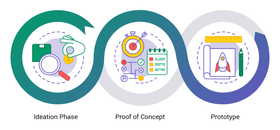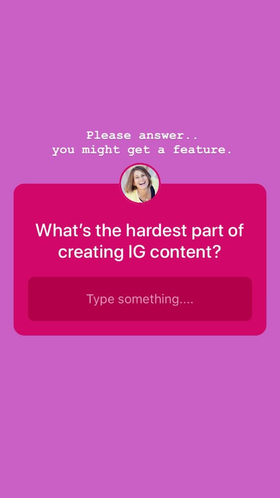How to Create a Marketing Strategy for D2C Brands
Since D2C brands have end-to-end control over all of their processes, it’s essential to have a comprehensive marketing strategy in place.
Read More
Today’s businesses have it tough. The consumer-driven and technology-based startup field is home to thousands of new ideas — but a great idea doesn’t necessarily mean immediate success. In fact, almost 90% of new startups never make it off the ground and 95% of new products struggle to find a market and end up failing.
Before jumping headfirst into selling a product, businesses need to iterate on their idea by building a “proof of concept.”
Proof of concept (POC) is a test conducted to validate that a product or idea is feasible to take to the commercialization stage. For many companies, especially those that focus on one or two products, a proof of concept can be an essential component of early stage planning of building a business.

Proof of concept is a key step before actually prototyping and launching a product. Source
A POC can be a document, presentation, or demo. Companies provide it to potential investors, managers, and other stakeholders to demonstrate the idea’s viability and gain approval and funding.
A POC report contains a range of information and data learned during the testing process, including:
Customer feedback
Competitor research
Business analysis
Projected financials
Go-to-market strategy
Depending on the complexity of the idea, proof of concept development may be more or less intricate and detailed. Ideally, though, it shouldn’t take longer than a few weeks or months to complete.
A POC may sound like a pitch, but it’s more thorough than that. Its purpose is not just to entice investors with marketing hype. Rather, a POC aims to prove to all stakeholders that there is a need in the market and that the idea is ROI positive.
The POC process varies greatly depending on the type of product, the complexity of the development phase, the intended target audience, and more. For example, the POC for a business-to-business (B2B) software solution must show the capabilities of the technology and its features, and how it fits within client systems and requirements. This is clearly different from a POC for a new toy or other B2C product.
Regardless of niche or vertical, every potential business idea should follow these essential steps for thorough proof of concept development:
The first stage of a POC is proving that the idea fills a need or gap in the market. If it does, it’s far more likely to attract a customer base and succeed.
The best way to prove a need in the market is by identifying potential customers and understanding their pain points. How does the business idea or product solve the customer’s problem? What is it about the product that would entice people to buy it? You can find the answers to questions like these by engaging directly with customers and getting their feedback.
Companies can accomplish this first step with the help of online market research tools, such as Survey Monkey and Recollective. Focus groups and face-to-face interviews are also effective ways to accurately assess customer sentiment.

Instagram Story polls are a great way to get a ton of insight from your target audience. Source
Any business or product must have a large or loyal customer audience to succeed. According to a PwC Innovation study, 35% of companies say that customers are their most important innovation partners. Companies shouldn’t underestimate the power of customer feedback in the earliest stages of the proof of concept.
For more on identifying potential customers and their pain points:
Before jumping in and developing a fully-fledged prototype, create a basic product version and test it on a focus group of potential customers. Based on the test group’s feedback and experience, teams can further develop according to their market or demographic’s needs.
This incremental approach saves time and effort, enabling minimum use of resources to get maximum effective feedback. The demo can undergo necessary iterations based on repeated adjustments and testing until arriving at a minimum viable product (MVP) that’s more likely to lead to success in the commercialization stage.

When it comes to creating a MVP, duct tape and glue are A-OK. Source
If there are budget and time constraints, consider using social media to validate your product idea.
Minimum Viable Products or MVPs allow companies to launch a product or service quickly and cost-effectively. In a competitive landscape, prompt launches can be a lifesaver. More importantly, they provide an essential test base of customers, which can influence feature development. These customers can even help with idea validation: If the MVP fails to gain traction, it could signify that further resources and time aren’t a wise investment.
Once the market demand for the idea is validated and the demo finalized, the next step is outlining in detail the step-by-step strategy for getting the idea to market. This will require research and planning of the technical aspects, including manufacturing, logistics, distribution, marketing, and sales, as well as a breakdown of the financials involved.
The roadmap must show that the commercialization process is lean, optimized, and a worthwhile investment.
On the one hand, a POC is not a sales pitch. It’s a feasibility study that provides investors with the proof they need to feel secure and commit to necessary funding. However, investors are human like everyone else. The best way to capture their attention (and investment) is to go beyond the dry financials and technical proof by weaving them into a compelling and engaging story.
Whether a document, report, or presentation, the POC should incorporate classic storytelling techniques, much like any small business marketing plan. This can be achieved using personas that add human dimension to ensure investors don’t get bored and lose interest.
Always remember to focus on the larger question — how does the product or idea change the world, improve humanity, or (more realistically) make the customer’s life better? The big-picture impact is key to creating a convincing POC.
For storytelling tips:
Eager to get to market, many businesses rush through the POC process or skip it altogether. This is a big mistake. Taking the time and resources to develop a POC is an important part of the development process and can help prevent a product from becoming one of the vast majority that ends up in the dustbin.
Here are several reasons why a solid POC is necessary:
The primary aim of a POC is to test whether an idea can be realized as a marketable, profitable product. Is there a need or gap in the market? Who’s the potential customer base? Is it a worthwhile investment? Will it be ROI positive? The POC provides answers to these questions and validates the idea before anyone invests money, manpower, or time.
Every investor wants to know that they are backing a winner. However, no serious investor will fund an “idea.” A POC provides proof that the concept is financially sound, and is vital to attracting interest and funding from investors, senior managers, and other decision-makers.
A POC provides a clear picture of the problems that may arise during the development and marketing phase. For example, a POC can show that the pain points the product addresses aren’t actually aligned with the target customer base. This kind of problem can be identified during the surveying stage based on focus groups and customer feedback. Then, the concept can be altered to better match the real consumer need.
The POC may reveal that the MVP needs a major adjustment to meet the needs and expectations of the end user. Resolving these issues is far easier during the POC process than during the development or commercialization phase. The costs involved are negligible compared to the costs of redesigning a prototype or re-issuing a new, updated product.
A POC provides an opportunity for a theoretical “dry run” to test the costs, time frames, parameters, and requirements of product development without any risk. Developing a product is hugely time consuming and expensive. A POC outlines the entire commercialization process in advance and involves a preparation stage to boost the probability of success.
As you develop your POC, you’ll dive deeper into your product or idea. A great POC will include information about your customer profile, sales and marketing plans, and competitors, which will be tremendously useful as you move closer to your launch date.
But these research learnings alone aren’t enough to sustain growth in the long term. For the best results, you’ll need to make sure you integrate all your data, analytics, and cross-channel tracking as sales start rolling in. AdRoll can provide you with the insights and numbers you need — check out how our Cross-Channel Performance Dashboard can supercharge your campaigns and marketing efforts.
When there’s just a 5% chance that a new product will succeed and a 10% chance that a new startup will survive, the importance of the POC becomes crystal clear. “Good ideas” hit store shelves every day, and most will certainly fail. The POC process is about building a case and showing investors the idea’s true value.
In the court of approval, the difference between “yea” and “nay” will come down to the rigor and quality of the evidence presented in the POC. If a company is serious about getting investors on board and their product to market, a POC is not a choice — it’s a necessity.
Creating a POC and MVP for your product development takes time and resources, but that investment is essential. Leveraging them as part of your marketing strategy can be just as important. Learn more about creating a strategic marketing plan with our resources below.
Need some extra help developing your proof of concept template? This proof of concept worksheet can help.
While concepts like proof of concept, prototype, and minimum viable product may sound similar or be used together, each one represents different stages of the product development process. It may be tempting to rush through each stage or skip them altogether to launch products faster, but each step plays an integral part in a company’s go-to-market strategy.
A proof of concept is a basic version of the idea or product. Its purpose is to demonstrate that the idea isn’t just feasible, but worth pursuing.
A prototype is an early version of a product. While it can provide users with realistic experiences and showcase the look and function of a product, it’s usually not complete. Many prototypes lack end-stage features but demonstrate core functions enough to go through the testing process.
A minimum viable product describes any final-stage product with the basic features necessary for effective customer use. Minimum viable products offer a complete experience, even though they lack optional features a company may want to add in the future.
Last updated on March 14th, 2023.